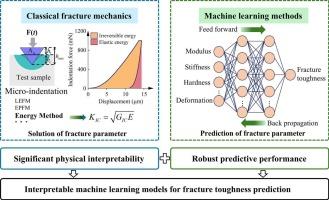Symbolic regression guided by interpretable machine learning for formulating a fracture toughness law from micro-indentation data
IF 5.6
2区 工程技术
Q1 ENGINEERING, MECHANICAL
引用次数: 0
Abstract
Although artificial intelligence (AI) plays a crucial role in material property prediction, its models often lack interpretability, and the physical mapping relationships behind their excellent performance are seldom addressed. This work introduces a systematic framework designed to remove redundancy from high-dimensional features and discover underlying mathematical laws. Specifically, we demonstrate this framework by deriving an explicit fracture toughness law from micro-indentation data. This framework, centered on Symbolic Regression (SR), leverages the SHapley Additive exPlanations (SHAP) technique to analyze a trained Artificial Neural Network (ANN). The ANN is first trained on mechanical parameters, including elastic–plastic and fracture properties. Subsequently, the SHAP technique is integrated to quantify feature importance and reduce dimensionality, thereby laying the groundwork for SR to uncover the physical equation. The results show that the ANN model’s generalization capability is improved by removing certain features based on their ranked importance. Three dominant features, namely indentation modulus (EIT), hardness (HIT), and creep deformation (Hcreep), are identified as key predictors and subsequently fed into a symbolic regression model to investigate the potential functional relationship between elastic–plastic properties and fracture toughness. After balancing model accuracy and complexity, the nonlinear relationship between elastic–plastic properties and fracture toughness is described by an SR-generated mathematical equation. In total, this work bridges data-driven modeling with classical fracture mechanics, offering a compact, explainable relationship for estimating fracture toughness in complex geomaterials.

由可解释机器学习指导的符号回归从微压痕数据中制定断裂韧性规律
尽管人工智能(AI)在材料性能预测中发挥着至关重要的作用,但其模型往往缺乏可解释性,并且其出色性能背后的物理映射关系很少得到解决。这项工作引入了一个系统框架,旨在从高维特征中去除冗余并发现潜在的数学规律。具体来说,我们通过从微压痕数据中推导出明确的断裂韧性规律来证明这一框架。该框架以符号回归(SR)为中心,利用SHapley加性解释(SHAP)技术来分析经过训练的人工神经网络(ANN)。人工神经网络首先训练力学参数,包括弹塑性和断裂性能。随后,结合SHAP技术量化特征重要性和降维,为SR揭示物理方程奠定基础。结果表明,通过根据重要性排序去除特定特征,提高了人工神经网络模型的泛化能力。三个主要特征,即压痕模量(EIT)、硬度(HIT)和蠕变变形(Hcreep),被确定为关键预测因子,随后被输入到符号回归模型中,以研究弹塑性性能与断裂韧性之间的潜在函数关系。在平衡了模型的精度和复杂性后,用sr生成的数学方程描述了弹塑性性能与断裂韧性之间的非线性关系。总的来说,这项工作将数据驱动模型与经典断裂力学相结合,为估计复杂岩土材料的断裂韧性提供了一种紧凑、可解释的关系。
本文章由计算机程序翻译,如有差异,请以英文原文为准。
求助全文
约1分钟内获得全文
求助全文
来源期刊

Theoretical and Applied Fracture Mechanics
工程技术-工程:机械
CiteScore
8.40
自引率
18.90%
发文量
435
审稿时长
37 days
期刊介绍:
Theoretical and Applied Fracture Mechanics'' aims & scopes have been re-designed to cover both the theoretical, applied, and numerical aspects associated with those cracking related phenomena taking place, at a micro-, meso-, and macroscopic level, in materials/components/structures of any kind.
The journal aims to cover the cracking/mechanical behaviour of materials/components/structures in those situations involving both time-independent and time-dependent system of external forces/moments (such as, for instance, quasi-static, impulsive, impact, blasting, creep, contact, and fatigue loading). Since, under the above circumstances, the mechanical behaviour of cracked materials/components/structures is also affected by the environmental conditions, the journal would consider also those theoretical/experimental research works investigating the effect of external variables such as, for instance, the effect of corrosive environments as well as of high/low-temperature.
 求助内容:
求助内容: 应助结果提醒方式:
应助结果提醒方式:


